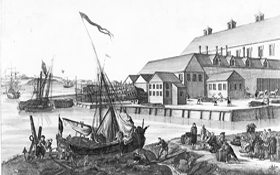Salem Town and Village
The events of 1692 are generally referred to as Salem witchcraft. However, there were two overlapping but distinct geographic entities that comprised Salem, Massachusetts. The earliest events associated with the outbreak occurred in Salem Village, which was the location of the ministry house of Samuel Parris. It was in the village that the examinations were initially conducted to hear evidence against the accused.
Salem Village was a fast-growing farming area on the northern edge of Salem Town. The town was a prosperous port engaged in commerce, fishing, shipbuilding, and other activities associated with a trading and urban area. The village, roughly five to seven miles from the town's meeting house, constituted, in effect, a parish or ward of the town, and served as its agricultural hinterland. The population of Salem Town and Village at the time of the witch trials cannot be stated with precision, but a reasonable estimate for the population of the combined area was about 2000 residents, with the population of Salem Village numbering between 500 and 600 residents.
Following the pattern common to other New England communities, as the village grew, it began to develop a distinctive identity and separate interests from the town. Most significantly, by the 1670s, the farmers requested their own church due to their distance from the town. For some villagers, though by no means all, a separate church represented a broader ambition for greater autonomy or even complete independence from the town, something that would not occur until 1752 (Salem Village is now called Danvers). Salem Town initially objected to the farmers' request, but in March 1672, with a push from the colonial government, the town granted Salem Village the liberty to hire a minister for themselves. The village was also permitted to establish a committee, "not exceeding the number of five," to assess and gather taxes for the ministry. Its members were usually elected each year at a village meeting. Villagers still continued to participate in town life, voted in town elections, and paid most town taxes, but for certain purposes, primarily dealing with their own church, they had a degree of autonomy.
To learn about the Salem Village church, click Next.
